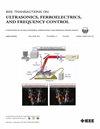Validation of Volumetric Multifrequency Shear Wave Vibro-Elastography With Matrix Array Transducer for the In Vivo Liver
IF 3
2区 工程技术
Q1 ACOUSTICS
IEEE transactions on ultrasonics, ferroelectrics, and frequency control
Pub Date : 2024-12-17
DOI:10.1109/TUFFC.2024.3519192
引用次数: 0
Abstract
Three-dimensional shear wave absolute vibro-elastography (S-WAVE) is a steady-state, volumetric elastography imaging technique similar to magnetic resonance elastography (MRE), with the additional advantage of multifrequency imaging and a significantly shorter examination time. We present a novel ultrasound matrix array implementation of S-WAVE for high-volume refresh rate acquisition. This new imaging setup is equipped with real-time shear wave monitoring for an improved data collection workflow and image quality. The image processing and elasticity reconstruction pipeline is tailored for high body mass index (BMI) subjects. We characterized this system with tissue phantoms and a human study cohort composed of 7 healthy volunteers and 25 patients with nonalcoholic fatty liver disease. The validation results show that S-WAVE can maintain a high agreement with the liver tissue stiffness measurements obtained with both the 2-D and 3-D MRE techniques, with an average cross correlation >93% and an average基于矩阵阵列传感器的体内肝脏体积多频横波振动弹性成像验证
三维横波绝对振动弹性成像(S-WAVE)是一种类似于磁共振弹性成像(MRE)的稳态体积弹性成像技术,具有多频成像的额外优势和显著缩短的检查时间。我们提出了一种新的超声矩阵阵列实现S-WAVE高容量刷新率采集。这种新的成像装置配备了实时横波监测,以改进数据收集工作流程和图像质量。图像处理和弹性重建管道是为高体重指数(BMI)受试者量身定制的。我们用组织幻影和一个由7名健康志愿者和25名非酒精性脂肪肝患者组成的人类研究队列来描述这个系统。验证结果表明,S-WAVE与二维和三维MRE技术测量的肝组织刚度保持较高的一致性,平均相互关系>为93%,平均${R} ^{{2}} =0.87$,优于传统的瞬态弹性技术。我们的研究结果表明,基于矩阵阵列的3-D S-WAVE是一种合适的体积弹性成像解决方案,可以以更方便、更灵活、更经济的方式提供与MRE类似的肝纤维化评估。
本文章由计算机程序翻译,如有差异,请以英文原文为准。
求助全文
约1分钟内获得全文
求助全文
来源期刊
CiteScore
7.70
自引率
16.70%
发文量
583
审稿时长
4.5 months
期刊介绍:
IEEE Transactions on Ultrasonics, Ferroelectrics and Frequency Control includes the theory, technology, materials, and applications relating to: (1) the generation, transmission, and detection of ultrasonic waves and related phenomena; (2) medical ultrasound, including hyperthermia, bioeffects, tissue characterization and imaging; (3) ferroelectric, piezoelectric, and piezomagnetic materials, including crystals, polycrystalline solids, films, polymers, and composites; (4) frequency control, timing and time distribution, including crystal oscillators and other means of classical frequency control, and atomic, molecular and laser frequency control standards. Areas of interest range from fundamental studies to the design and/or applications of devices and systems.

 求助内容:
求助内容: 应助结果提醒方式:
应助结果提醒方式:


